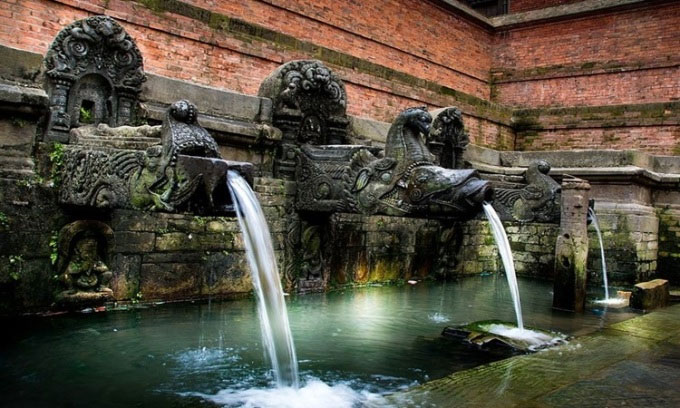Unique 1,600-year-old drinking water supply system in Nepal
Fountains connected to shallow tanks and water channels from streams or underground aquifers provide abundant water sources for the people of Nepal.
The country of Nepal , located between India and Tibet, has an extensive drinking water supply system, dating back to at least the 5th century. One of its most impressive features is its elaborate stone fountains. named dhunge dhara or hiti, looks like the sea monster makara in Hindu legend. Although the dhunge dhara is not as spectacular as the aqueduct of ancient Rome, the ingenious technology that helps bring water to the fountain is no less impressive, according to Interesting Engineering .

Nozzles at Manga Hiti project, Patan. (Photo: Wikimedia).
Dhunge dhara first appeared during the Licchavi kingdom (400 - 750 AD) . Some scholars suggest that similar systems may have existed earlier and that the Licchavis only organized and gave aesthetic shape to pre-existing structures. In Nepali culture, offering water to the gods is considered a praiseworthy act. Therefore, both kings and communities in the past built dhunge dhara in the region.
The Manga Hiti structure in Patan, built in 570 AD, is said to be the oldest dhunge dhara still in operation. Over time, more and more similar fountains began to appear throughout the Kathmandu valley. The Malla period (1201 - 1779) recorded the development of the fountain system.
The basic water source of the dhunge dhara is a network of canals that carry water from mountain streams. Others come from underground aquifers. Dhunge dhara exploits underground sources often built on shallow tanks with a depth determined by the water table. These tanks are built from stone and brick with faucets protruding from the wall. While most tanks have just one tap, there are many fountains that have 2, 3, 5, 9 or even more taps like the Muktidhara structure in Mustang district with 108 taps. Located above each faucet there is always a small temple dedicated to a god. Excess water is stored in ponds or piped to cultivated fields for irrigation.
In the late 17th century, before plumbing was widespread, fountains were an important source of drinking water. Although their importance has since declined, dhunge dharas still operate, serving about 10% of the population in the Kathmandu Valley. Even today, dhunge dhara is an integral part of the daily lives of many residents. They use them for bathing and washing purposes. This is also the place where religious rituals such as cleaning idols are performed.
- Vietnamese engineer turns air magic into water
- Detection of brain feeding amoeba in the US water supply system
- Drinking water this way, cancer, diabetes will never reach you
- Water drinking habits to remember
- Turn cars into gas ... drinking water
- What to do when drinking water is contaminated
- 2,000-year-old swimming pool
- Equipment to produce clean drinking water from dilute air
- Interesting facts about Nepal
- The earth 'stirred' under the influence of the earthquake in Nepal
- 9th graders 'turn' air conditioner waste into drinking water
- 'Millions of dollars' is spent on filtering urine into drinking water
 Norway built the world's tallest wooden tower
Norway built the world's tallest wooden tower Kremlin
Kremlin Ashurbanipal: The oldest royal library in the world
Ashurbanipal: The oldest royal library in the world Decoding the thousand-year construction of Qin Shihuang shocked the world
Decoding the thousand-year construction of Qin Shihuang shocked the world Shocking discovery about the Earth's 'tail'
Shocking discovery about the Earth's 'tail'  Top 10 Unbelievable Ways Animals Survive in Dangerous Environments
Top 10 Unbelievable Ways Animals Survive in Dangerous Environments  Mysterious wonders of the world
Mysterious wonders of the world  The largest animals that lived in the desert, still exist today
The largest animals that lived in the desert, still exist today  Why can submarines dive and surface?
Why can submarines dive and surface?  2,000-year-old Mayan invention could save us
2,000-year-old Mayan invention could save us 